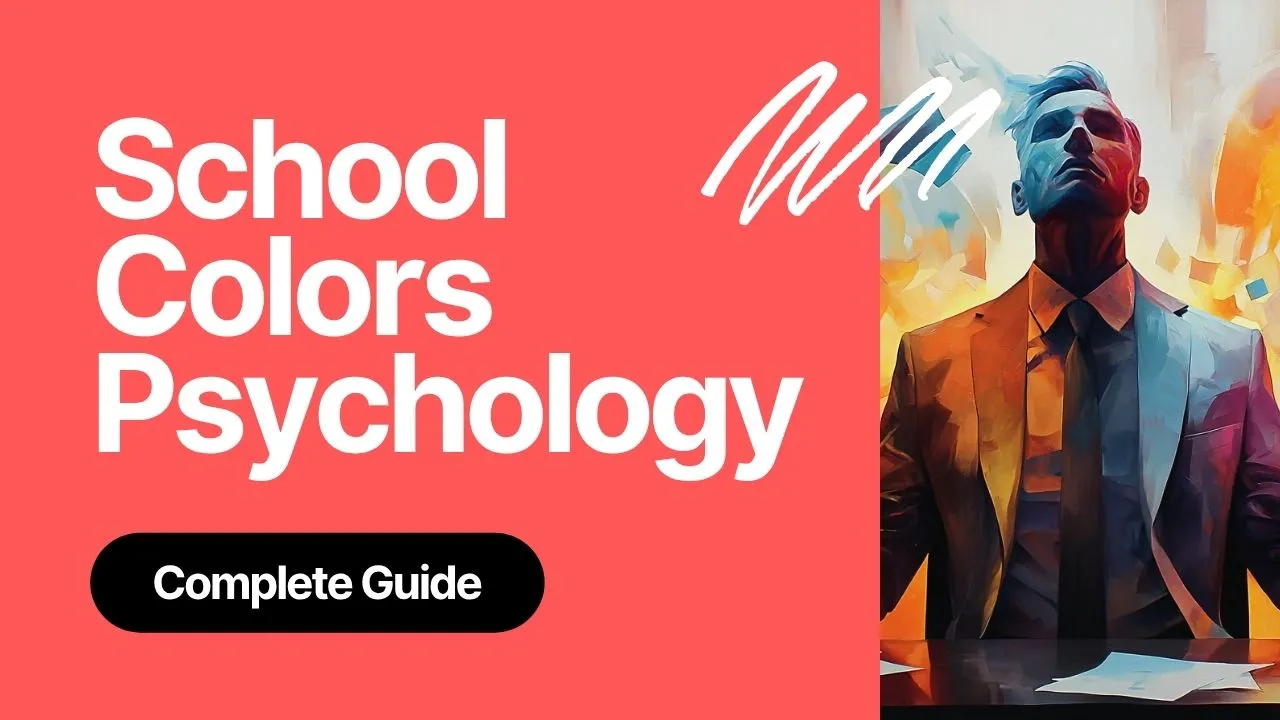School Branding Blog
School Colors Psychology: Complete Guide to Choosing Colors (2025)

School Colors Psychology: The Complete Guide to Choosing Colors That Drive Enrollment
Your school colors do more than decorate uniforms and hallways—they’re powerful psychological tools that influence how parents, students, and the community perceive your institution. The right color palette can convey academic excellence, build trust with families, and create emotional connections that drive enrollment decisions.
Yet many schools choose colors based on tradition, personal preference, or what “looks nice” without understanding the psychological impact these choices have on their most important audiences.
After analyzing color strategies across 250+ successful school branding projects, we’ve identified the psychological principles and strategic frameworks that make school colors work for enrollment, engagement, and community building.
Looking for vendor-ready color rules? Download our Brand Guidelines Template and set exact HEX/RGB/CMYK specs with do/don’t usage. For complete visual identity systems including strategic color palettes, explore our visual identity design agency services.
The Science Behind School Color Psychology
How Colors Influence Decision-Making
Research in environmental psychology shows that colors trigger immediate emotional and cognitive responses that influence behavior:
- Subconscious Processing: The brain processes color information 60,000 times faster than text
- Emotional Associations: Colors create instant emotional connections before rational evaluation
- Memory Formation: Color increases brand recognition by up to 80%
- Trust Building: Appropriate color choices can increase perceived credibility by 42%
For Schools: This means your color choices are influencing parent enrollment decisions, student engagement, and community support before anyone reads your mission statement or tour your facilities.
The Parent Perspective: Colors That Build Confidence
When parents research schools, they’re making high-stakes decisions about their children’s futures. Color psychology plays a crucial role in building the confidence and trust necessary for enrollment.
Colors That Build Parental Trust:
- Navy Blue: Conveys stability, professionalism, and academic rigor
- Forest Green: Suggests growth, balance, and environmental consciousness
- Burgundy/Maroon: Implies tradition, sophistication, and established excellence
- Charcoal Gray: Projects modernity, professionalism, and forward-thinking
Colors That May Create Hesitation:
- Bright Pink: Can be perceived as unserious for academic institutions
- Neon Colors: May suggest lack of professionalism or stability
- All Black: Can feel intimidating or unwelcoming to families
- Brown: Often associated with outdated or underfunded institutions
Strategic Color Psychology by School Type
Elementary Schools: Colors for Growth and Safety
Primary Psychological Goals:
- Create feelings of safety and nurturing
- Encourage creativity and exploration
- Build parent confidence in child development
Effective Color Strategies:
🟢 Green + Gold: Growth and achievement
- Green: Development, nature, balance
- Gold: Success, optimism, warmth
- Message: “Your child will grow and succeed here”
🔵 Blue + Orange: Trust and energy
- Blue: Safety, stability, trust
- Orange: Creativity, enthusiasm, fun
- Message: “Safe environment that sparks curiosity”
🟣 Purple + Silver: Creativity and excellence
- Purple: Imagination, wisdom, creativity
- Silver: Innovation, modernity, quality
- Message: “Where creativity meets academic excellence”
Middle Schools: Colors for Transition and Identity
Primary Psychological Goals:
- Support identity development
- Balance structure with creativity
- Appeal to both students and parents
Effective Color Strategies:
🔴 Red + Gray: Energy and stability
- Red: Passion, determination, school spirit
- Gray: Balance, maturity, professionalism
- Message: “Energetic environment with strong foundation”
🟦 Teal + White: Growth and clarity
- Teal: Communication, clarity, emotional balance
- White: New beginnings, potential, cleanliness
- Message: “Clear path through the middle school years”
🟠 Orange + Navy: Enthusiasm and achievement
- Orange: Confidence, creativity, social connection
- Navy: Academic excellence, tradition, stability
- Message: “Where social growth meets academic success”
High Schools: Colors for Achievement and Future Success
Primary Psychological Goals:
- Convey academic rigor and college preparation
- Build school pride and community connection
- Attract families focused on outcomes
Effective Color Strategies:
🔵 Royal Blue + Gold: Excellence and achievement
- Royal Blue: Leadership, confidence, academic excellence
- Gold: Success, achievement, prestige
- Message: “Preparing leaders for bright futures”
🟢 Hunter Green + Silver: Growth and innovation
- Hunter Green: Ambition, prosperity, stability
- Silver: Technology, innovation, modernity
- Message: “Traditional values, modern preparation”
🔴 Crimson + White: Passion and purity of purpose
- Crimson: Determination, strength, school spirit
- White: New beginnings, potential, clarity
- Message: “Passionate pursuit of excellence”
The Psychology of Color Combinations
Two-Color Systems: Maximum Impact
Most successful school color schemes use two primary colors that create psychological balance:
Complementary Pairs (Opposite on color wheel):
- Blue + Orange: Trust + Energy
- Red + Green: Passion + Growth
- Purple + Yellow: Creativity + Optimism
Analogous Pairs (Adjacent on color wheel):
- Blue + Green: Calm + Growth
- Red + Orange: Energy + Enthusiasm
- Purple + Blue: Creativity + Trust
Three-Color Systems: Added Sophistication
Adding a third color (usually neutral) provides flexibility and sophistication:
Primary + Secondary + Neutral:
- Navy + Gold + White: Excellence with clarity
- Forest Green + Silver + Charcoal: Growth with innovation
- Burgundy + Gold + Cream: Tradition with warmth
Cultural and Regional Considerations
Geographic Color Preferences
Different regions have varying color associations based on local culture, climate, and traditions:
Northeast: Traditional colors (navy, burgundy, forest green) convey established excellence Southeast: Warmer colors (red, orange, gold) reflect regional energy and hospitality West Coast: Modern combinations (teal, gray, orange) suggest innovation and progress Midwest: Balanced palettes (blue, green, gold) emphasize stability and growth
Demographic Considerations
Affluent Communities: Prefer sophisticated, understated colors that suggest exclusivity Diverse Communities: Benefit from inclusive colors that don’t favor specific cultural associations Rural Areas: Often connect with earth tones and traditional combinations Urban Areas: May prefer modern, bold combinations that stand out
Common School Color Mistakes
Mistake 1: Following Trends Over Psychology
Problem: Choosing trendy colors that don’t align with educational goals Solution: Select colors based on desired psychological impact, not current design trends
Mistake 2: Too Many Colors
Problem: Complex color schemes that dilute brand recognition Solution: Limit primary palette to 2-3 colors maximum
Mistake 3: Ignoring Practical Applications
Problem: Colors that don’t work across all school materials and environments Solution: Test colors in various applications before finalizing
Mistake 4: Cultural Insensitivity
Problem: Colors that have negative associations in community cultures Solution: Research cultural color meanings in your specific community
Strategic Color Selection Framework
Step 1: Define Your Psychological Goals
Questions to Answer:
- What emotions do we want parents to feel about our school?
- What qualities do we want to emphasize? (tradition, innovation, excellence, creativity)
- How do we want students to feel in our environment?
- What differentiates us from competing schools?
Step 2: Analyze Your Community
Research Areas:
- Demographic preferences and cultural considerations
- Competitor color analysis
- Regional color traditions and expectations
- Parent survey data on color preferences
Step 3: Test Color Impact
Testing Methods:
- Focus groups with target parent demographics
- A/B testing of marketing materials with different color schemes
- Student feedback on environmental color applications
- Community surveys on color associations
Step 4: Plan for Implementation
Implementation Considerations:
- Cost of changing existing materials and signage
- Timeline for gradual vs. immediate color transition
- Staff and community communication strategy
- Merchandise and uniform implications
Successful School Color Psychology in Action
Case Study: Henderson Collegiate
Challenge: New charter school needed colors that conveyed both innovation and academic rigor to attract high-achieving families.
Color Strategy: Navy blue (trust, excellence) + bright orange (energy, innovation)
Psychological Impact:
- Navy blue built parent confidence in academic quality
- Orange differentiated from traditional schools
- Combination suggested “serious about education, exciting about learning”
Results: 40% over-enrollment in first year, with parents specifically mentioning the “professional yet energetic” brand impression.
Case Study: Woodbridge School District
Challenge: District rebrand needed colors that worked across elementary through high school while building community unity.
Color Strategy: Forest green (growth, stability) + gold (achievement, optimism) + white (clarity, potential)
Psychological Impact:
- Green conveyed continuous growth across all grade levels
- Gold emphasized achievement and success
- White provided clean, modern application flexibility
Results: Increased community support for bond measures and improved district-wide school pride.
Advanced Color Psychology Strategies
Seasonal Color Applications
Fall/Winter: Deeper, warmer tones that convey stability and focus Spring/Summer: Brighter applications that emphasize growth and energy
Digital vs. Physical Color Considerations
Digital Applications: Colors may appear more vibrant and need adjustment for screen viewing Physical Applications: Consider lighting conditions, material textures, and environmental factors
Age-Appropriate Color Psychology
Elementary: Brighter, more playful applications of school colors Middle School: Balanced approach that respects growing maturity High School: Sophisticated applications that convey college-readiness
Ready to Harness Color Psychology for Your School?
Strategic color selection is one of the most powerful tools in school branding, yet it’s often overlooked or approached without psychological understanding. The right colors can strengthen enrollment, build community pride, and create lasting emotional connections with your school.
Our school branding strategy service includes comprehensive color psychology analysis and strategic palette development. We help schools choose colors that align with their goals, resonate with their communities, and drive measurable results.
See color psychology in action:
- Henderson Collegiate - Strategic color choice for rapid growth
- Woodbridge School District - District-wide color unity
- Bridgewater-Raritan High School - Modern color application
Whether you’re launching a new school, rebranding an existing institution, or simply want to optimize your current colors for better results, we can help you harness the power of color psychology.
Ready to discover your optimal color strategy? Get a free color psychology consultation and learn how strategic color choices can transform your school’s impact and enrollment success.
Part of our Parent Psychology & Decision-Making content cluster.
This guide explores how color influences parent perception. For the complete picture, read our pillar guide: How School Branding Influences Parent Choice - Deep dive into parent psychology, decision-making factors, and enrollment drivers.
We Build and Manufacture Mascot Costumes
A professionally built mascot costume creates unforgettable moments at games, rallies, and community events.

See Full Details →
Design to Delivery
We manage everything
6-12 Week Delivery
In time for your season
Safety First
Ventilation & visibility
Starts at $2,500
Professional quality
About Mash Bonigala
Mash Bonigala is the Founder & CEO of School Branding Agency. Over the past 15 years, he's helped 250+ K-12 schools transform their brand identity and drive enrollment growth. From charter schools to public districts, Mash specializes in creating mascot systems and brand strategies that rally communities, boost school spirit, and convert prospects into enrolled families. Schedule a Zoom call to discuss your school →
Mascot logo design
Get an enrollment-ready mascot your community loves
Start with our mascot logo design service. We’ll craft a distinctive, on‑brand mascot system and rollout plan tailored for your school.
Start your estimateRelated
Charter Application Branding - Professional Identity for Authorizer Approval
Professional charter application branding that demonstrates operational readiness to authorizers. Complete brand identity, website, and application materials. Charter-specific packages from $8K.
View detailsRelated
Charter School Branding - Mascots & Identity (2025)
We help charter schools build mascots and identity systems that rally communities and support enrollment. See packages and proof.
View details
